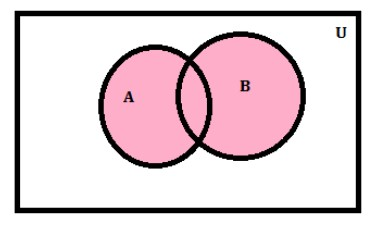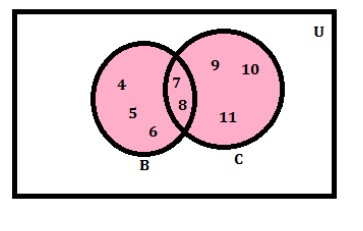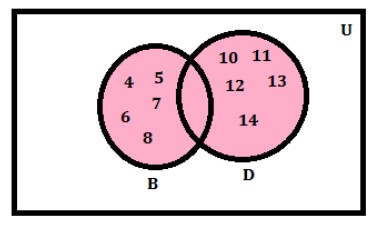
If B = {4, 5, 6, 7, 8}, C = {7, 8, 9, 10, 11} and D = {10, 11, 12, 13, 14}. Find (i) $B\cup C$ (ii) $B\cup D$.
Answer
594.9k+ views
Hint:The union of two sets A and B is the set of elements which are in A, in B, or in both A and B. The union of two sets A and B, written $A\cup B$, is the combination of the two sets.
Complete step-by-step answer:
The symbol used for the union of two sets is $\cup $.
Therefore, symbolically, we write union of the two sets A and B is $A\cup B$ which means A union B.
Therefore, \[A\cup B\text{ }=\text{ }\{x\text{ }:\text{ }x\in A\text{ }or\text{ }x\in B\}\]
Now let’s draw the venn diagram to find A union B.

The given sets are
B = {4, 5, 6, 7, 8},
C = {7, 8, 9, 10, 11}
D = {10, 11, 12, 13, 14}
(i) The union of two sets B and C is the set of elements which are in both B and C.
Taking every element of both the sets B and C, without repeating any element,
we get
$B\cup C=\left\{ 4,5,6,7,8,9,10,11 \right\}$
Now let’s draw the venn diagram to find B union C.

(ii) The union of two sets B and D is the set of elements which are in both B and D.
Taking every element of both the sets B and D, without repeating any element,
we get
$B\cup D=\left\{ 4,5,6,7,8,10,11,12,13,14 \right\}$
Now let’s draw the venn diagram to find B union D.

Note: You might get confused between the union and intersection of sets. In the case of union, all the elements are included in the result, but in the case of the intersection, only the common elements are considered.
Complete step-by-step answer:
The symbol used for the union of two sets is $\cup $.
Therefore, symbolically, we write union of the two sets A and B is $A\cup B$ which means A union B.
Therefore, \[A\cup B\text{ }=\text{ }\{x\text{ }:\text{ }x\in A\text{ }or\text{ }x\in B\}\]
Now let’s draw the venn diagram to find A union B.

The given sets are
B = {4, 5, 6, 7, 8},
C = {7, 8, 9, 10, 11}
D = {10, 11, 12, 13, 14}
(i) The union of two sets B and C is the set of elements which are in both B and C.
Taking every element of both the sets B and C, without repeating any element,
we get
$B\cup C=\left\{ 4,5,6,7,8,9,10,11 \right\}$
Now let’s draw the venn diagram to find B union C.

(ii) The union of two sets B and D is the set of elements which are in both B and D.
Taking every element of both the sets B and D, without repeating any element,
we get
$B\cup D=\left\{ 4,5,6,7,8,10,11,12,13,14 \right\}$
Now let’s draw the venn diagram to find B union D.

Note: You might get confused between the union and intersection of sets. In the case of union, all the elements are included in the result, but in the case of the intersection, only the common elements are considered.
Recently Updated Pages
Two men on either side of the cliff 90m height observe class 10 maths CBSE

What happens to glucose which enters nephron along class 10 biology CBSE

Cutting of the Chinese melon means A The business and class 10 social science CBSE

Write a dialogue with at least ten utterances between class 10 english CBSE

Show an aquatic food chain using the following organisms class 10 biology CBSE

A circle is inscribed in an equilateral triangle and class 10 maths CBSE

Trending doubts
The shortest day of the year in India

Why is there a time difference of about 5 hours between class 10 social science CBSE

Write a letter to the principal requesting him to grant class 10 english CBSE

What is the median of the first 10 natural numbers class 10 maths CBSE

The Equation xxx + 2 is Satisfied when x is Equal to Class 10 Maths

What is the missing number in the sequence 259142027 class 10 maths CBSE




